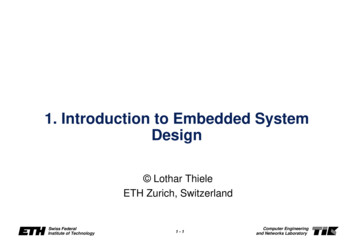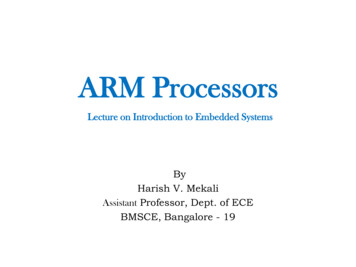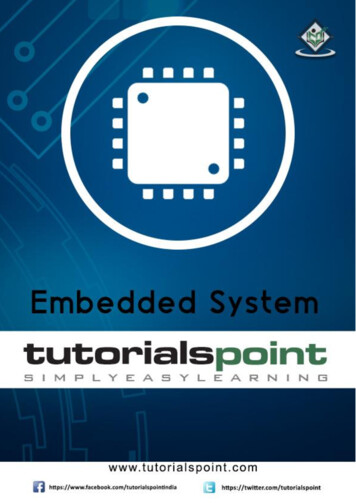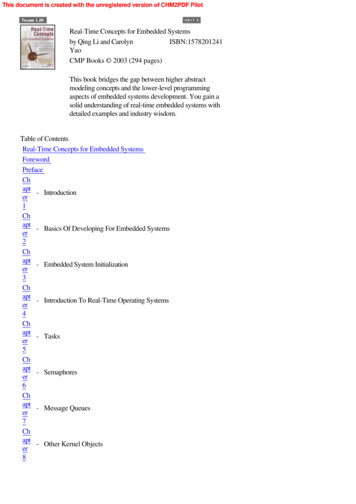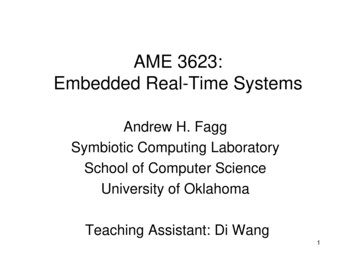
Transcription
AME 3623:Embedded Real-Time SystemsAndrew H. FaggSymbiotic Computing LaboratorySchool of Computer ScienceUniversity of OklahomaTeaching Assistant: Di Wang1
What is an Embedded System?Andrew H. Fagg: Embedded RealTime Systems: Introduction2
What is an Embedded System? Computing system with a non-standardinterface (often no keyboard or screen) Often involved in sensing and control (andmay not even talk to a human) Typically a custom system for a veryspecific applicationAndrew H. Fagg: Embedded RealTime Systems: Introduction3
What is an Embedded System?(cont) Limited processing capabilities:– Can be extremely small– Can require a small amount of power Can have significant real-time constraints– Act on inputs very quickly– Generate high-frequency outputs Often a higher expectation of reliabilityAndrew H. Fagg: Embedded RealTime Systems: Introduction4
Examples of Embedded SystemsAndrew H. Fagg: Embedded RealTime Systems: Introduction5
RoboticsMark TildenLos AlamosNational Labsand Wowweepicture fromRobosapiensAndrew H. Fagg: Embedded RealTime Systems: Introduction6
Humanoid RoboticsNASA/JSC RobonautUMass Torso7
Real-Time Robotic ControlAndrew H. Fagg: Embedded RealTime Systems: Introduction8
Dual-Limb Coordination9
Personal SatelliteAssistantsNASA AmesResearch Centerpicture fromRobosapiensAndrew H. Fagg: Embedded RealTime Systems: Introduction10
IntelligentProstheticsHugh HerrMIT Leg Labpicture fromRobosapiens11
Sensor Networks1000 sensornodesAndrew H. Fagg: Embedded RealTime Systems: Introduction13
Embedded Systems ChallengesAndrew H. Fagg: Embedded RealTime Systems: Introduction14
Embedded Systems Challenges Sensing the environment:– Sensors are typically far from ideal (noise,nonlinearities, etc.)– Sensors/subsystems can fail– Hard to get a ‘complete’ view of theenvironment Affecting the environment through“actuators”– Application can require fast, preciseresponsesAndrew H. Fagg: Embedded RealTime Systems: Introduction15
Embedded Systems Challenges(cont) Testing/debugging can be very difficult:– Hard to identify and replicate all possible situations– Often involves the interaction of many differentcomponents– Often no standard user interface– Limited on-board resources with which to recordsystem state Competing requirements of cost, complexity,design time, size, power Andrew H. Fagg: Embedded RealTime Systems: Introduction16
Embedded Systems Challenges(cont) Lack of reliability can be a killer .literallyAndrew H. Fagg: Embedded RealTime Systems: Introduction17
My Assumptions About You Circuits and sensors class (or equivalent):– Boolean logic and circuits (AND/OR/NOT gates)– Analog circuits (in particular, resistive-capacitivecircuits) Some background in programming– We will be using C for all projects Everyone has a laptop that can be used for theprojectsAndrew H. Fagg: Embedded RealTime Systems: Introduction18
Course GoalsBy the end of this course, you will be able to: design and implement embedded circuitsinvolving microcontrollers, sensors andactuators, design, program and debug embedded sensingand control software, work in collaborative teams to solve systemdesign and implementation problems, and communicate in both oral and written forms withteam members.Andrew H. Fagg: Embedded RealTime Systems: Introduction19
Sources of Information Primary readings: web pages and book sections (postedon D2L) Optional textbooks:– Designing Embedded Hardware, John Catsoulis, O'Reilly, 2005,2nd Edition, ISBN: 0-596-00755-8– Embedded C Programming and the Atmel AVR, Richard H.Barnett, Sarah Cox, Larry O'Cull (2006), 2nd Edition,Thomson/Delmar Learning, ISBN: 1418039594 Class web page: www.cs.ou.edu/ fagg/classes/ame3623 Desire2Learn: learn.ou.eduYou are responsible for making sure that you have accessto all of these resourcesAndrew H. Fagg: Embedded RealTime Systems: Introduction20
Andrew H. Fagg: Embedded RealTime Systems: Introduction21
Class Schedulewww.cs.ou.edu/ fagg/classes/ame3623/schedule.html Lecture plans Required readingAndrew H. Fagg: Embedded RealTime Systems: Introduction22
Channels of Communication Lecture Class email list: time-critical messages tothe class Desire2Learn announcements Desire2Learn discussion group: you maypost questions (and answers) Private email or office hours for non-publicquestions/discussionsAndrew H. Fagg: Embedded RealTime Systems: Introduction23
Grading Components of your grade:– Midterm exam: 10%– Final exam: 20%– Four homework assignments and several popquizzes: 25%– Five projects: 40%– In-class participation: 5% Grades will be posted on the Desire2Learn Final grades boundaries will be selected basedon the overall class distributionAndrew H. Fagg: Embedded RealTime Systems: Introduction24
Exams Closed book/closed notes– Exception: you are allowed 1 page of your own notes Assigned seating No electronic devices Grading questions must be addressed beforethe returned exams leave the classroomAndrew H. Fagg: Embedded RealTime Systems: Introduction25
Homework Assignments Individual work Hand-in:– Through the digital dropbox of Desire2Learnor hardcopy– By 5:00 on the due date (no exceptions) Grading questions must be addressedwithin one week of being returnedAndrew H. Fagg: Embedded RealTime Systems: Introduction26
Group Projects Five group projects will focus on sensorprocessing and design of robot controlcircuits– Control of a hovercraft Project Topics:– Sensor interface and processing– Intra-processor communication– Finite-state machines and microcontrollersAndrew H. Fagg: Embedded RealTime Systems: Introduction27
Project GradingGroup grades are a function of: Code correctness and readability Documentation Demonstration and presentationIndividual grades: Personal contribution (must have 2 significantcontributions over the course of the semester) Group grade scaled by your personalcontributionAndrew H. Fagg: Embedded RealTime Systems: Introduction28
Group Projects (cont) Groups will be of size 3-4 and will be assignedBe ready to demonstrate project by the due dateProjects require more than a day to completeProject reports in pdf or postscript formatProjects may be late (but I do not recommendthis):– 0-24 hrs: 10% penalty– 24-48 hrs: 20% penalty– 48 hrs: 100% penaltyAndrew H. Fagg: Embedded RealTime Systems: Introduction29
Classroom Conduct Ask plenty of questions Contribute to the discussions No: cell phone use (including texting) No: laptop use (except for classroomexercises) More details in the syllabusAndrew H. Fagg: Embedded RealTime Systems: Introduction31
Academic Conduct/MisconductHomework assignments: All work must be your own: no looking ator copying solutions from other students orfrom the net General discussion is OK (e.g., thefundamental skills that we are learning) When in doubt: askAndrew H. Fagg: Embedded RealTime Systems: Introduction32
Academic Conduct/MisconductProjects: All work must be that of your group: nolooking at, discussing or copying solutionsfrom other groups (or from the net) General discussion is (again) OKSecure your dataAndrew H. Fagg: Embedded RealTime Systems: Introduction33
Next Time Analog circuits review Review readings: see the schedule pageAndrew H. Fagg: Embedded RealTime Systems: Introduction34
Andrew H. Fagg: Embedded Real-Time Systems: Introduction 15 Embedded Systems Challenges Sensing the environment: – Sensors are typically far from ideal (noise, nonlinearities, etc.) – Sensors/subsystems can fail – Hard to get a ‘complete’ view of the en





